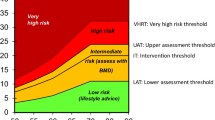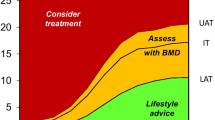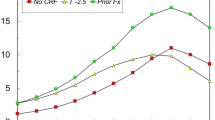Abstract
Summary
Under current guidelines, based on prior fracture probability thresholds, inequalities in access to therapy arise especially at older ages (≥70 years) depending on the presence or absence of a prior fracture. An alternative threshold (a fixed threshold from the age of 70 years) reduces this disparity, increases treatment access and decreases the need for bone densitometry.
Introduction
Several international guidelines set age-specific intervention thresholds at the 10-year probability of fracture equivalent to a woman of average BMI with a prior fracture. At older ages (≥70 years), women with prior fracture selected for treatment are at lower average absolute risk than those selected for treatment in the absence of prior fracture, prompting consideration of alternative thresholds in this age group.
Methods
Using a simulated population of 50,633 women aged 50–90 years in the UK, with a distribution of risk factors similar to that in the European FRAX derivation cohorts and a UK-matched age distribution, the current NOGG intervention and assessment thresholds were compared to one where the thresholds remained constant from 70 years upwards.
Results
Under current thresholds, 45.1 % of women aged ≥70 years would be eligible for therapy, comprising 37.5 % with prior fracture, 2.2 % with high risk but no prior fracture and 5.4 % selected for treatment after bone mineral density (BMD) measurement. Mean hip fracture probability was 11.3, 23.3 and 17.6 %, respectively, in these groups. Under the alternative thresholds, the overall proportion of women treated increased from 45.1 to 52.9 %, with 8.4 % at high risk but no prior fracture and 7.0 % selected for treatment after BMD measurement. In the latter group, the mean probability of hip fracture was identical to that observed in women with prior fracture (11.3 %). The alternative threshold also reduced the need for BMD measurement, particularly at older ages (>80 years).
Conclusions
The alternative thresholds equilibrate fracture risk, particularly hip fracture risk, in those with or without prior fracture selected for treatment and reduce BMD usage at older ages.




Similar content being viewed by others
References
Kanis JA, McCloskey EV, Johansson H, Cooper C, Rizzoli R, Reginster JY (2013) European guidance for the diagnosis and management of osteoporosis in postmenopausal women. Osteoporos Int 24(23–57):23079689
Grigorie D, Sucaliuc A, Johansson H, Kanis JA, McCloskey E (2013) FRAX-based intervention and assessment thresholds for osteoporosis in Romania. Arch Osteoporos 8(164):24390553
Compston J, Bowring C, Cooper A et al (2013) Diagnosis and management of osteoporosis in postmenopausal women and older men in the UK: National Osteoporosis Guideline Group (NOGG) update 2013. Maturitas 75(392–396):23810490
Lekamwasam S (2013) Sri Lankan FRAX model and country-specific intervention thresholds. Arch Osteoporos 8(148):23975235
Tuzun S, Eskiyurt N, Akarirmak U, Saridogan M, Johansson H, McCloskey E, Kanis JA (2012) The impact of a FRAX-based intervention threshold in Turkey: the FRAX-TURK study. Arch Osteoporos 7(229–235):23060308
Lekamwasam S, Adachi JD, Agnusdei D et al (2012) A framework for the development of guidelines for the management of glucocorticoid-induced osteoporosis. Osteoporos Int 23(2257–2276):22434203
National Institute for Health and Care Excellence (2012) NICE Clinical Guideline 146. Osteoporosis: assessing the risk of fragility fracture
Kanis JA, Johnell O, Oden A, Johansson H, McCloskey E (2008) FRAX and the assessment of fracture probability in men and women from the UK. Osteoporos Int 19(385–397):18292978
Hippisley-Cox J, Coupland C (2012) Derivation and validation of updated QFracture algorithm to predict risk of osteoporotic fracture in primary care in the United Kingdom: prospective open cohort study. BMJ 344(e3427):22619194
Compston J, Cooper A, Cooper C, Francis R, Kanis JA, Marsh D, McCloskey EV, Reid DM, Selby P, Wilkins M (2009) Guidelines for the diagnosis and management of osteoporosis in postmenopausal women and men from the age of 50 years in the UK. Maturitas 62(105–108):19135323
Bruyere O, Fossi M, Zegels B, Leonori L, Hiligsmann M, Neuprez A, Reginster JY (2013) Comparison of the proportion of patients potentially treated with an anti-osteoporotic drug using the current criteria of the Belgian national social security and the new suggested FRAX criteria. Rheumatol Int 33(973–978):22842952
Briot K, Cortet B, Thomas T et al (2012) 2012 update of French guidelines for the pharmacological treatment of postmenopausal osteoporosis. Joint Bone Spine 79(304–313):22521109
Johansson H, Oden A, Johnell O, Jonsson B, de Laet C, Oglesby A, McCloskey EV, Kayan K, Jalava T, Kanis JA (2004) Optimization of BMD measurements to identify high risk groups for treatment—a test analysis. J Bone Miner Res 19(906–913):15190881
Johansson H, Kanis JA, Oden A, Compston J, McCloskey E (2012) A comparison of case-finding strategies in the UK for the management of hip fractures. Osteoporos Int 23(907–915):22234810
NICE (2010) TA161 (amended) Alendronate, etidronate, risedronate, raloxifene, strontium ranelate and teriparatide for the secondary prevention of osteoporotic fragility fractures in postmenopausal women. National Institute for Health and Clinical Excellence
Dawson-Hughes B, Looker AC, Tosteson AN, Johansson H, Kanis JA, Melton LJ 3rd (2010) The potential impact of new National Osteoporosis Foundation guidance on treatment patterns. Osteoporos Int 21(41–52):19705046
Dawson-Hughes B, Tosteson AN, Melton LJ 3rd, Baim S, Favus MJ, Khosla S, Lindsay RL (2008) Implications of absolute fracture risk assessment for osteoporosis practice guidelines in the USA. Osteoporos Int 19(449–458):18292975
Hagino H (2014) Revised osteoporosis diagnostic criteria and Japanese practice guideline on osteoporosis. Clin Calcium 24:11–18, 24369275
Kanis JA, McCloskey EV, Johansson H, Strom O, Borgstrom F, Oden A (2008) Case finding for the management of osteoporosis with FRAX—assessment and intervention thresholds for the UK. Osteoporos Int 19(1395–1408):18751937
Borgstrom F, Strom O, Coelho J, Johansson H, Oden A, McCloskey EV, Kanis JA (2010) The cost-effectiveness of risedronate in the UK for the management of osteoporosis using the FRAX. Osteoporos Int 21(495–505):19565175
Dawson-Hughes B, Looker AC, Tosteson AN, Johansson H, Kanis JA, Melton LJ 3rd (2012) The potential impact of the National Osteoporosis Foundation guidance on treatment eligibility in the USA: an update in NHANES 2005–2008. Osteoporos Int 23(811–820):21717247
Acknowledgments
We thank the Committee of Scientific Advisors for its critical review and endorsement of the manuscript.
Conflicts of interest
None.
Author information
Authors and Affiliations
Corresponding author
Rights and permissions
About this article
Cite this article
McCloskey, E., Kanis, J.A., Johansson, H. et al. FRAX-based assessment and intervention thresholds—an exploration of thresholds in women aged 50 years and older in the UK. Osteoporos Int 26, 2091–2099 (2015). https://doi.org/10.1007/s00198-015-3176-0
Received:
Accepted:
Published:
Issue Date:
DOI: https://doi.org/10.1007/s00198-015-3176-0




